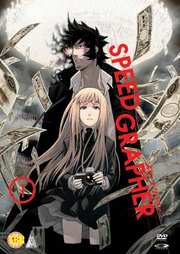Speed Grapher: Vol. 1
Introduction
Stick your first episode of anime on, and you'll quickly realise that you are not in Kansas any more. Of course there is the given, that anime is a medium, not a genre, and as such is targeted at all audiences, explaining why some shows are adult in nature, some aimed at female audiences, some male, and some for children. But even those shows made for children cause palpitations in the guardians of all that is good in the West. Here we must protect the children, keep 'dangerous' material away from their precious little heads. It isn't so in Japan, where there is a more liberal approach, believing that children can indeed handle concepts like life and death, love and hate, and can accept that the world we live in can be a brutal and violent one. It's why I'm always scratching my head, when an episode of Naruto gets rated 15, a show which in Japan plays mostly to preteen audiences. Then again, with that news story a few years back, about a boy in the US dying after trying to copy a stunt in Naruto, maybe the guardians of all that is good have a point. Maybe kids in the West are more stupid. But the fact is that there usually is no sugar coating with Japanese animation, something that I find refreshing. But it does make you wonder what an anime that deliberately set out to explore the seedy underbelly of humanity would look like. How would they handle depravity, decadence and the sordid depths of the human psyche? I went and bought Speed Grapher to find out.
Tatsumi Saiga was an acclaimed war photographer, back in the Economic Bubble War. It was a war that further deepened the divide between the haves and have nots, the rich got richer, and the poor became doormats. Tokyo is the city where the rich walk over the poor with impunity, and it's Tokyo where Saiga now practices his trade, no longer able to leave the country. But he's suited to this decadent capital, a man who can only be aroused when he has his camera in hand. He works as a freelance photographer, when he isn't being the plaything of Detective Ginza, a woman who needs a gun in her hand to get sexual pleasure. You'd think that they would be perfectly suited to each other, but Saiga wants more, and his pursuit of a killer story leads him into the depraved underworld, a secret club under Roppongi. It's here where he encounters a teenaged goddess; it's here where he obtains an amazing new power. Now when he looks through the lens of his camera and clicks the shutter, whatever he snaps explodes.
The first four episodes are released on this disc from MVM.
1. Depravity City
Tatsumi Saiga was a war photographer during the Economic Bubble War, but now he's working in the playground of the rich, Tokyo, trying to recapture the same thrill he once got as he captured the dying moments of an enemy soldier. He's currently working on a story concerning a particular Drug Reform Bill, a story that has already left a trail of corpses, and implicated a powerful Senator. Now he has a lead that literally leads him underground, to a secret club beneath Roppongi, run by a powerful man named Suitengu. Here, the rich and influential gather to play out their darkest desires, and revel in the acquisition of more power and money. A guy with a camera isn't welcome. When Saiga captures the Goddess Ceremony on film, when a young girl named Kagura descends from on high, to give the ultimate in pleasure or death to a fat bureaucrat, it seems that he's destined for a quick exit from this world. But before the swords descend, Kagura kisses him.
2. Goddess of Greed
Kagura is a normal teenaged girl. Well normal if you consider she is the daughter of the most powerful and influential woman in Tokyo, Shinsen Tennozu, lives in an exclusive penthouse and attends a prestigious private school. She's hardly normal in that she has nightmares about a strange, perverted ceremony, and her mother despises her for her youth and beauty, and is slowly starving her. When Kagura tells her teacher of her woes, and that teacher promises to sort things out, she doesn't expect her mother to buy her teacher off, in her own bed. Then her mother's close friend Suitengu shows up to take her to her piano lesson, and we learn that Kagura is under a hypnotic suggestion. She is the Goddess in a bizarre underground ceremony, expected to bestow joy or death to one lucky recipient. Except that an intruder, a photographer, interrupts the ceremony and before the swords fall, Kagura kisses the photographer.
3. Film Like a Bullet
Something strange has happened to Saiga. Now, when he looks through the viewfinder of his camera, and clicks the shutter, his subject explodes. He found that out by sheer luck, his instinct in the face of certain death compelling him to take a photograph, only to see his subject blow up. He takes advantage of the resulting confusion, and takes the Goddess and runs, with Suitengu's minions in pursuit. But when Kagura wakes up, she has no memory of the ceremony, or the mayhem that has just occurred. She does begin to put two and two together, and realise that the strange dreams she's been having aren't dreams at all. But their escape is short lived, and Suitengu's hunter, Tsujido finds and takes back Kagura, leaving Saiga for dead.
4. Lethal Headshot
Saiga isn't dead; he wants to get Kagura back, having promised to free her. Kagura's liberty seems more distant than ever, she's now been locked up in a cage, those around her asserting that she's a victim of sleepwalking, plagued by strange dreams. Kagura knows the difference between dreams and reality, and she knows her saviour will be acclaimed war photographer Tatsumi Saiga, as she's now familiar with his most famous image. However, if Saiga attempts to take Kagura, there's someone more formidable waiting for him. Saiga isn't the only one to have been bestowed with powers. There is a literally rubber-limbed dancer, a temperamental diva by day, and a serial killer with a penchant for decapitation by night. This isn't a foe that Saiga can simply 'vanish' by a camera click.
Picture
Speed Grapher gets a 1.78:1 anamorphic transfer, and it's par for the course for anime on DVD. You have your NTSC-PAL conversion issues, although not too many of them, the image is clear and sharp throughout, and the animation is smooth and detailed. It's a Gonzo product, so expect smart looking characters, a blending of traditional 2D and 3D CGI, and plenty of bang for your buck. In fact the characters in Speed Grapher are a little more edgy than usual for Gonzo, certainly suiting the decadent nature of the story, and it seems the animators went to dominatrix school for some of the get ups.
Sound
Audio-wise, you have the option of DD 5.1 English, and DD 2.0 Japanese, along with translated subtitles and a signs only track. I sampled the English, and it's pretty much like every other Funimation dub, and yes, Monica Rial is in it. You can expect a little added profanity if you want to partake of that surround sound option, but as usual I opted for the Japanese audio, and had no complaints, apart from a couple of dubious English accents, and the clichéd effeminate guy. The biggest annoyance is the absence of the original theme tune. For the opening theme, Funimation couldn't licence the original track Girl's On Film by Duran Duran (Stupid licensing laws, stupid greedy record companies), and had to use a track from within the show itself, Shutter Speed. In the show, Shutter Speed is fine background music, but as the show's opener, it's only so much repetitive noise, and the Duran Duran track is so much more appropriate. Check out the Youtube for as long as the link lives. Afterwards you'll just have to imagine it.
Extras
We have the usual anime presentation, animated menus, jacket picture, and multi-angle credit sequences. It does mean that each episode has two titles, one granted by Funimation and the title translated from the original Japanese. I've used the English episode titles to avoid confusion.
On the disc, you'll find the textless credits, trailers for Ikki Tousen and Gunsword, and a 90-second slideshow art gallery.
The big extra is 12 minutes of Character Cast Auditions, presented by ADR director Christopher Bevins, and it's an interesting look into the casting process, with audition tapes of the successful candidates used to punctuate his points.
Conclusion
Well, that was certainly an eye opener. Sex and violence are certainly not new to anime, neither are cute little girls or arcane super powers. Add to that the fact that this is a Gonzo story, which inevitably means a dark future dystopia resulting from some sort of world-changing cataclysm, as well as a mystery and conspiracies at the heart of the tale, and you would expect a weary cry of 'seen it all before' to be uttered from my lips. On the contrary, I have seen nothing like Speed Grapher before, that's despite it being made up of all those familiar ingredients that I have mentioned. Perhaps it's the approach it takes, which while it can never be accused of being wholly adult, certainly is more mature than the usual anime. Perhaps it's the frank way it approaches the subject matter. This is an anime about the seedy underbelly of human existence; it's about the abuse of power, the rich grinding the poor into the dirt, while they waste their endless money on orgiastic excess. It would be very easy to giggle at the fat politician in a leather thong being whipped by a dominatrix, but that sort of humour would be thoroughly out of place in Speed Grapher. This show works well in keeping the audience edgy and uncomfortable.
It's certainly replete with interesting characters, although none of them can be easily categorised as hero or villain at this point, especially when our first encounter with the show's protagonist Saiga, sees him being aroused by the sight of a man's death through his viewfinder. It transpires that he has been seeking death through his camera ever since, to recapture that thrill. If there is an innocent in this show, it's Kagura, who is a victim of her mother's jealous abuse, is a victim of Suitengu's hypnotic control, and who even though she is heir to Tokyo's most powerful family, longs for a vaguely glimpsed freedom. She's broken and damaged at this point, a damsel that needs rescuing, and Saiga turns out to be the knight in tarnished armour.
Everyone else occupies a place in the spectrum of reprehensibility, the most vile being Kagura's mother Shinsen, who hates her own daughter for her youth, takes pleasure in toying with her mind, and sees nothing wrong in starving her. You'd think briefly that Kagura's teacher would come to her aid, and indeed she does start off with righteous indignation to Kagura's penthouse mansion, only to be bought off with money and sex. Suitengu runs the exclusive and hedonistic club for Tokyo's elite, where any pleasure, no matter how vile, despicable, or illegal, can be had for the right price. It's an exclusive playground for politicians and businessmen, and it transpires a sort of mystical freemasonry, where the entranced Kagura imparts amazing powers to those willing to pay. Suitengu is the hidden face of Shinsen's empire, and he has a host of henchmen and heavies to do his bidding, and deal out death and violence to those who cannot pay the club's exorbitant fees. Even the police are hardly angels, lining their own pockets rather than serving and protecting. Saiga has a somewhat kinky relationship with Detective Ginza, a woman who's a little too fond of her gun (What is it with psychopathic women in anime licking their weapons? Don't answer that) and any encounter between the two is fiery to say the least. She spends as much time playing the stock market as she does doing police work, and she has the commissioner wrapped around her finger.
The show starts off in a really appealing way. The first episode introduces the Saiga character, and we follow him on his investigation of a political scandal, and we also learn just how he was damaged by his experiences in the Bubble War, and how his attempts to recapture that thrill lead him deeper and deeper into trouble. The second episode resets the clock, and we meet Kagura, and learn how miserable her life as heiress to one of the most powerful people in Tokyo is, how she is used and abused, and how she is a prisoner of circumstance. We follow her to that same point in time where we left Saiga in the first episode, and then the story begins as Saiga gains his new power, and attempts to flee with Kagura. Of course at this early point in the story, there are countless questions, about the society of the future, the nature of these abilities that are being created, basically just a general, "What the hell is going on?" It makes the anticipation for the next volume intense. Fortunately I bought the lot in one go.
You can watch people being scummy to each other every morning on ITV, but it takes Gonzo to offer the dark side of humanity in such an appealing and compelling way. Speed Grapher is dark, edgy and borderline nasty. It's why I started watching anime in the first place.
























































Your Opinions and Comments
Be the first to post a comment!